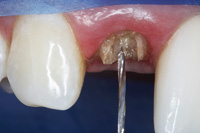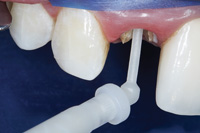Home › Forums › Endodontics & conservative dentistry › Influence Of White And Gray Endodontic Posts On Color Change › POST AND CORE
BRIEF HISTORICAL BACKGROUND
For more than 250 years, clinicians have written about the placement of posts in the roots of teeth to retain restorations.1 As early as 1728, Pierre Fauchard described the use of “tenons,” which were metal posts screwed into the roots of teeth to retain bridges.1 In the mid-1800s, wood replaced metal as the post material, and the “pivot crown,” a wooden post fitted to an artificial crown and to the canal of the root, was popular among dentists.1 Often, these wooden posts would absorb fluids and expand, frequently causing root fractures.2 In the late 19th century, the “Richmond crown,” a single-piece post-retained crown with a porcelain facing, was engineered to function as a bridge retainer.2 During the 1930s, the custom cast post-and-core was developed to replace the one-piece post crowns. This procedure required casting a post-and-core as a separate component from the crown.2 This 2-step technique improved marginal adaptation and allowed for a variation in the path of insertion of the crown.1
CAUSES OF POST-RETAINED CROWN FAILURE
The failure of post-retained crowns has been documented in several clinical studies (Figure 1).3 Many of these studies indicate that the failure rate of restorations on pulpless teeth with post-and-cores is higher than that for restorations of vital teeth.3
 |
 |
|
Figure 1a and 1b. Restorative failure of an all-ceramic crown on the maxillary right central occurring after endodontic treatment. A minimum of a 1 mm collar on sound tooth structure is required for a ferrule design. |
 |
 |
| Figures 2a and 2b. After determining the desired post channel length (one half to two thirds length of canal), the gutta-percha was removed with a series of pre-shaping instruments (Gates Glidden [SybronEndo]) (Rebilda post reamer [VOCO]). |
Several main causes of failure of post-retained restorations have been identified, including: recurrent caries, endodontic failure, periodontal disease, post dislodgement, cement failure, post-core separation, crown-core separation, loss of post retention, core fracture, loss of crown retention, post distortion, post fracture, tooth fracture, and root fracture.4-6 Also, corrosion of metallic posts has been proposed as a cause of root fracture.7
A COMPARISON OF CURRENT POST SYSTEMS
 |
 |
|
Figure 3. The channel preparation for a prefabricated fiber-reinforced post was performed using a color-coded drill (Rebilda post drill [VOCO]), establishing the desired intraradicular length and size for the selected post. |
Figure 4. The pre-selected fiber-reinforced composite post (Rebilda post [VOCO]) was placed into the channel space. The coronal height was measured and marked with a diamond disc to the desired length. The post is cleaned with alcohol, silanated (Ceramic Primer [VOCO]) for 60 seconds, and then air-dried. |
Today, the clinician can choose from a variety of post-and-core systems for different endodontic and restorative requirements. These systems and methods are well-documented in the literature.8-10 However, no single system provides the perfect restorative solution for every clinical circumstance, and each situation requires an individual evaluation.
Custom Cast Posts
The traditional custom-cast dowel core provides a better geometric adaptation to excessively flared or elliptical canals, and almost always requires minimum tooth structure removal.1 Custom cast post-and-cores adapt well to canals with extremely tapered canals or those with a noncircular cross section and/or irregular shape, and roots with minimal remaining coronal tooth structure.9 Patterns for custom cast posts can be formed either directly in the mouth or indirectly in the laboratory. Regardless, this method requires 2 appointment visits and a laboratory fee.
 |
 |
| Figures 5a and 5b. A dual-curing, self-etch adhesive (Futurabond DC [VOCO]) was applied with an applicator (Endo Tim [VOCO]) to the base of the post space and air-dried. Any excess adhesive was absorbed with an endodontic paper point using a rapid intermittent movement. |
 |
|
Figure 6. A dual-cure, resin cement (Bifix QM [VOCO]) was injected into the post channel using an angled tip (Intraoral Tip Type 1 [VOCO]). It is important to remove the tip slowly while injecting, to prevent incorporation of air bubbles. |
 |
 |
| Figures 7a and 7b. The fiber post was immediately inserted into the post hole to the base of the prepared channel and light-cured from different positions for 2 minutes (7a). After polymerization, the fiber post was cut with a diamond bur to the predetermined length. Never use a serrated instrument or shears because this can damage the integrity of the post(7b). |
Also, because it is cast in an alloy with a modulus of elasticity that can be as high as 10 times greater than natural dentin,11 this possible incompatibility can create stress concentrations in the less rigid root, resulting in post separation and failure. Additionally, the transmission of occlusal forces through the metal core can focus stresses at specific regions of the root, causing root fracture.11Furthermore, upon aesthetic consideration, the cast metallic post can result in discoloration and shadowing of the gingiva and the cervical aspect of the tooth.